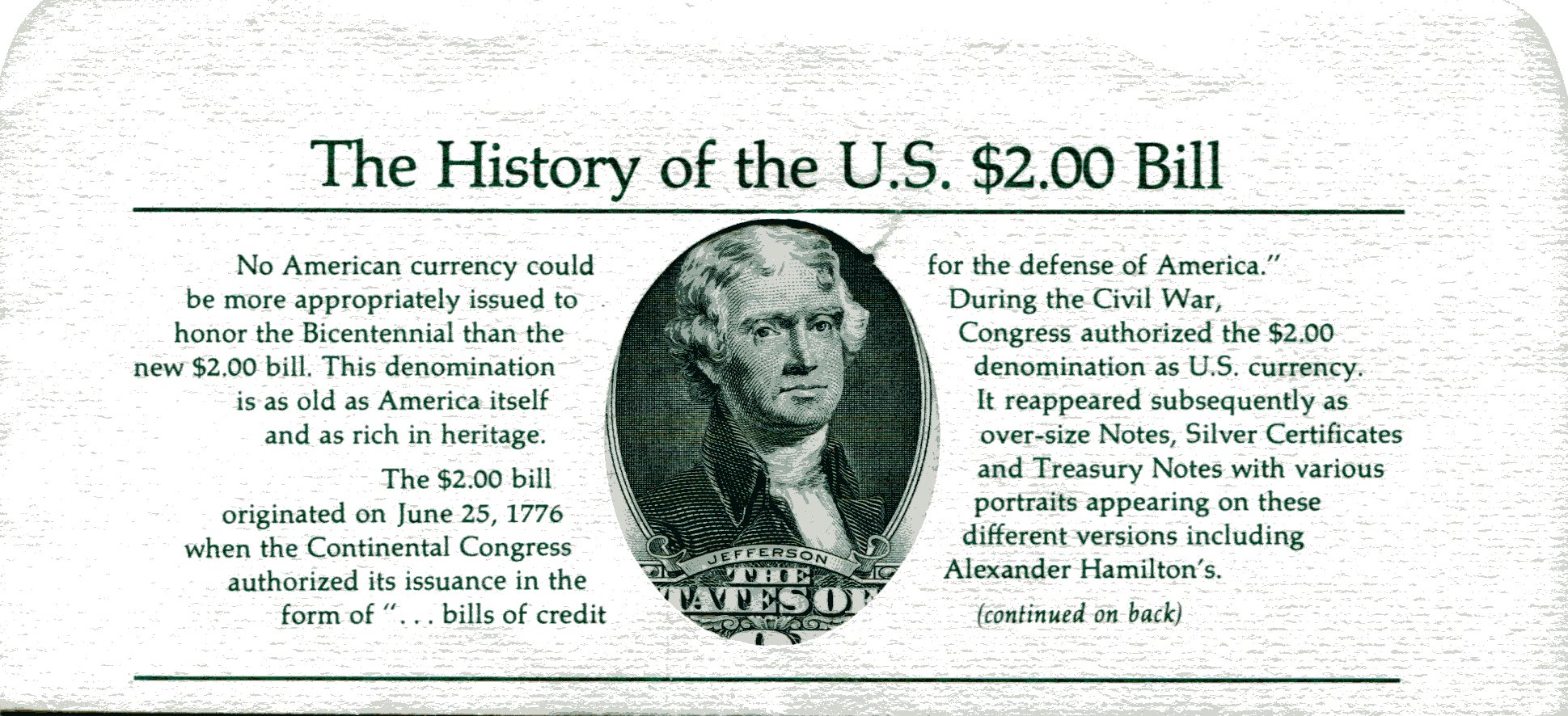Today’s the day to mention the $2 bill. Or more exactly, the $2 Federal Reserve Note, which began circulating again on April 13, 1976, or 40 years ago today, after being discontinued for about a decade. The date was chosen because today is also Thomas Jefferson’s birthday (273rd today, 233rd back in 1976).
My Series 1976 $2 note is one make for the Federal Reserve Bank of Minneapolis. As a collector’s item, I’m pretty sure it’s worth around $2. I keep it anyway, because I want to have at least one.
For the the resurrection of the denomination, someone produced paper envelopes with a canned history of the $2 bill printed on the front and back, and an oval hole on the front to display Jefferson. It’s an odd thing, but somehow I still have one.

 Unfortunately, I don’t have any older notes. The ones to have would be the Series 1886 $2 Silver Certificate depicting Gen. Winfield Scott Hancock, or the Series 1891 $2 Silver Certificate, with a portrait of U.S. Treasury Secretary William Windom. Or even the 1896 “Educational Series” Silver Certificate, which features an allegorical figure of Science presenting steam and electricity to commerce and manufacturing on the observe, and Robert Fulton and Samuel F. B. Morse on the reverse. They sure don’t make ’em like that any more.
Unfortunately, I don’t have any older notes. The ones to have would be the Series 1886 $2 Silver Certificate depicting Gen. Winfield Scott Hancock, or the Series 1891 $2 Silver Certificate, with a portrait of U.S. Treasury Secretary William Windom. Or even the 1896 “Educational Series” Silver Certificate, which features an allegorical figure of Science presenting steam and electricity to commerce and manufacturing on the observe, and Robert Fulton and Samuel F. B. Morse on the reverse. They sure don’t make ’em like that any more.
Anyway, when I take a check to the bank, I sometimes get $2 bills. They sometimes find their way into tips, though more often I get dollar coins for that purpose.
On the FAQ page at the Treasury Department web site, there’s the following question: “Why did the Treasury Department remove the $2 bill from circulation?”
The answer: “The $2 bill has not been removed from circulation and is still a circulating denomination of United States paper currency. The Federal Reserve System does not, however, request the printing of that denomination as often as the others. The Series 2003 $2 bill was the last printed and bears the names of former Secretary of the Treasury John W. Snow and Treasurer Rosario Marin. As of April 30, 2007 there were $1,549,052,714 worth of $2 bills in circulation worldwide. [You’d think Treasury could come up with newer numbers than that.]
“The key for successfully circulating the $2 bill is for retailers to use them just like any other denomination in their daily operations. In addition, most commercial banks will readily supply their retail customers with these bills if their customers request them in sufficient volume to justify stocking them in their vaults. However, neither the Department of the Treasury nor the Federal Reserve System can force the distribution or use of any denomination of currency on banks, businesses or individuals.”
The reserve of the post-1976 note features a reproduction of the painting “The Declaration of Independence” by John Trumbull. Not all of the original image could be squeezed onto the note, however, so some of the delegates depicted at either edge of painting were left off of the note. I remember that caused a minor flap at the time, with (I think) Congressmen of the states so slighted complaining about it. Forty years on, absolutely no one cares.